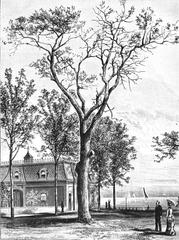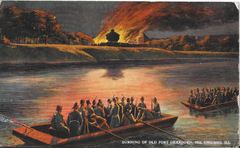
Battle of Fort Dearborn Site, Chicago: Visiting Hours, Tickets, and Historical Significance
Date: 14/06/2025
Introduction: The Enduring Legacy of Fort Dearborn
Fort Dearborn, once situated at the vital crossing of the Chicago River and Lake Michigan, remains a cornerstone of Chicago’s early history. Established in 1803 under Captain John Whistler and named for then Secretary of War Henry Dearborn, the fort was built to secure the Northwest Territory following the Treaty of Greenville. Its presence marked the transformation of the region from Native American land to a bustling frontier settlement, controlling crucial trade and transportation routes.
The fort’s most tragic episode—the Battle of Fort Dearborn on August 15, 1812—culminated in a violent confrontation between evacuating U.S. forces and Potawatomi warriors during the War of 1812, resulting in heavy casualties and the fort’s destruction. This event reflects the broader narrative of early American expansion, Indigenous resistance, and the cultural changes that shaped the city’s foundations.
Although the original fort no longer stands, visitors today can explore commemorative parks, monuments, and plaques that honor its layered past. This guide offers comprehensive details on visiting hours, tickets, accessibility, and nearby attractions, ensuring a rewarding experience for both history enthusiasts and casual travelers. For deeper exploration, see the Chicago History Museum and Chicagology - Fort Dearborn Massacre Memorial.
Table of Contents
- Introduction
- Historical Overview
- Visiting Information
- Cultural Significance and Interpretation
- Frequently Asked Questions (FAQ)
- Conclusion & Visitor Resources
Historical Overview
Founding and Strategic Importance
In 1803, the U.S. Army built Fort Dearborn under the command of Captain John Whistler, following directives from Secretary of War Henry Dearborn. Its strategic location at the mouth of the Chicago River allowed the U.S. to control access between the Great Lakes and the interior, establishing a military and trading post at what would become the heart of modern Chicago (Windy City Ghosts).
Life at Fort Dearborn
The original wooden fort included barracks, a powder magazine, and support buildings, surrounded by a growing community of settlers, interpreters, merchants, and fur traders such as John Kinzie. The fort signaled the beginning of permanent European-American settlement in the region, standing as a symbol of the city’s transformation from a Native crossroads to a frontier town.
The War of 1812 and the Battle of Fort Dearborn
Amid rising tensions during the War of 1812, the fort’s garrison, led by Captain Nathan Heald, was ordered to evacuate as British forces advanced. On August 15, 1812, the departing group was ambushed by about 500 Potawatomi warriors near present-day 18th Street and Calumet Avenue. The ensuing battle resulted in over 60 U.S. casualties, with survivors taken captive and the fort subsequently burned (Chicagology, Chicago Magazine, Wikipedia).
The battle had lasting consequences, accelerating government efforts to forcibly relocate Native American tribes, leading to the Potawatomi’s displacement by 1833.
Reconstruction and Urban Transformation
Fort Dearborn was rebuilt in 1816 with improved defenses and expanded facilities, briefly abandoned in 1823, and re-garrisoned in 1828. With Chicago’s incorporation in 1837, the fort was decommissioned in 1840. Urban growth, river engineering, fires, and the Great Chicago Fire of 1871 erased its physical remnants. Today, bronze plaques at Michigan Avenue and Wacker Drive, along with Battle of Fort Dearborn Park at 18th Street and Calumet Avenue, mark the fort’s legacy (Windy City Ghosts, Waymarking.com).
Commemoration and Legacy
Fort Dearborn’s legacy is commemorated in Chicago’s city flag (the fourth red star), Chicago Landmark designations, and public art such as the “Defense” sculpture by Henry Hering and the now-lost Carl Rohl-Smith monument. These markers, along with artifacts in the Chicago History Museum, continue to educate and inspire visitors.
Visiting Information
Hours and Admission
- Battle of Fort Dearborn Park (1801 S. Calumet Ave.) is open daily from dawn to dusk (Chicago Park District).
- Historical markers at Michigan Avenue and Wacker Drive are accessible at all hours, as part of the public sidewalk.
- Admission: Free; no tickets required.
Tours and Accessibility
- Guided tours: Available seasonally through local historical societies and tour operators, including some offered by the Chicago Architecture Center. Advance booking is advisable for guided experiences.
- Accessibility: Both the park and markers are wheelchair accessible, with paved paths and ramps. Nearby museums ensure ADA-compliant facilities.
Travel Tips and Getting There
- Public Transit: Use the CTA Red Line (State/Lake or Chicago stations), or buses serving Michigan Avenue and the South Loop. Plan your trip with the CTA Trip Planner.
- Parking: Limited street and garage parking nearby—public transit is recommended.
- Duration: Allow 15–30 minutes at the park; combine with other attractions for a longer visit.
Best Times to Visit and Nearby Attractions
- Best time: Spring through fall for comfortable walking and outdoor exploration.
- Nearby attractions:
- Chicago Riverwalk
- Museum Campus (Field Museum, Shedd Aquarium, Adler Planetarium)
- Magnificent Mile
- Chicago History Museum
Visual Highlights and Interactive Media
- Monuments and plaques: See the bronze markers at Michigan Avenue/Wacker Drive and interpretive signage in Battle of Fort Dearborn Park.
- Sculptures: The “Defense” bas-relief on the Michigan Avenue Bridge.
- Photography: Capture images of the memorials, plaques, and scenic city backdrops. Use alt text such as “Fort Dearborn Massacre Monument in Chicago” or “Battle of Fort Dearborn Park memorial plaque.”
Cultural Significance and Interpretation
The legacy of Fort Dearborn is complex and multifaceted. While early narratives described the 1812 conflict as the “Fort Dearborn Massacre,” modern scholarship and Indigenous voices emphasize its role as a military engagement within a broader struggle for sovereignty (University of Chicago Press, Great Warriors Path). Today, commemoration efforts strive for a balanced understanding, recognizing both the Potawatomi’s resistance and the experiences of settlers.
The site also features in local folklore as one of Chicago’s most haunted locations, with reported sightings near the markers and park (Windy City Ghosts). Archaeological finds have periodically revealed remains from the era, further connecting the present to the past.
Frequently Asked Questions (FAQ)
Q: What are Fort Dearborn’s visiting hours?
A: Battle of Fort Dearborn Park is open daily from dawn to dusk; historical markers are always accessible.
Q: Is there an admission fee?
A: No, admission is free for all outdoor memorials and parks.
Q: Are guided tours available?
A: Yes, seasonal guided walking tours are offered by local operators and the Chicago Architecture Center.
Q: Is the site accessible for people with disabilities?
A: Yes, paved paths and ramps ensure accessibility.
Q: Where are the main sites located?
A: Markers are at Michigan Avenue and Wacker Drive; Battle of Fort Dearborn Park is at 1801 S. Calumet Ave.
Q: What nearby attractions can I visit?
A: Chicago Riverwalk, Museum Campus, Magnificent Mile, Chicago History Museum.
Conclusion & Visitor Resources
Visiting the Battle of Fort Dearborn site offers a profound connection to Chicago’s layered past—highlighting themes of resilience, conflict, and evolving memory. While the original fort is gone, commemorative parks and markers invite reflection and discovery. Pair your visit with nearby attractions for a full day of exploration in the heart of Chicago.
Plan ahead:
- Use public transit for convenience.
- Consider a guided tour for deeper insights.
- Explore the Chicago History Museum for exhibits on early Chicago and Indigenous perspectives.
Stay informed:
- Download the Audiala app for curated audio tours and updates.
- Follow us on social media for event news and historical content.
Additional Resources and References
- Chicago History Museum
- Chicagology - Fort Dearborn Massacre Memorial
- Chicago Park District - Battle of Fort Dearborn Park
- University of Chicago Press - Rising Up from Indian Country
- Battle of Fort Dearborn - Wikipedia
- Chicago Magazine - The True Story of the Deadly Encounter at Fort Dearborn
- Windy City Ghosts - Fort Dearborn
- Great Warriors Path - Battle of Fort Dearborn
- Waymarking.com - Fort Dearborn Markers
- Mapcarta - Fort Dearborn Location
Image 1 Alt text: Historical marker at the Fort Dearborn site on Michigan Avenue, Chicago.
Image 2 Alt text: Map of downtown Chicago highlighting the Fort Dearborn historical markers and nearby attractions.































































































































































